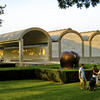More about The Butcher's Shop

Contributor
Annibale Carracci’s The Butcher’s Shop is a scene of hardworking tradesmen and a perfect example of Italian genre art.
It might seem strange that Carracci chose a butcher shop of all subjects to paint. Almost as if he didn’t know it would be chaotic inside. Or that it would smell of dead carcasses. And there would be blood everywhere. Then there’s the guts, the intestines, the splattered brains, the chopped limbs. Did Carracci really believe this would be a subject perfect for high art?
In a way, yes. He did. Carracci was all too aware of the ins and outs of butcher shops as he had uncles who were in the meat business. Artisans raised Carracci. The painter from Bologna had a large family of tailors, goldsmiths, copper engravers, and butchers. Carracci’s older brother, Agostino, paved the way to becoming an artist as Agostino realized there was money, lots and lots of money, to be made as a painter (assuming you could get some good commissions, of course).
Painting the trades was rare in Italian Renaissance portraits. Understandably. Who’s buying the portraits of butchers and blacksmiths? It’s more likely a portrait of a tailor’s creation would be painted, rather than the tailor himself. But Carracci was determined to bring front and center the cruel necessity of life: the act of killing. Despite living in Kingdoms and surrounded by the luxuries of silk dresses, delicious wines, and entertainment for the masses, killing to eat is part of everyday existence. It’s just not seen in the limelight as much. And The Butcher’s Shop doesn’t show the evidence of killing besides the carcasses strung up. The Butcher’s Shop is a cleaned-up version of what an actual butcher’s shop might look like at the time. For instance, try finding a single spot of blood on the aprons of the two butchers.
The subject of the butcher landed on Carracci’s lap via his teacher, Bartolomeo Passarotti. When Dutch artists began painting subjects the Italians thought to be unworthy to paint, like the poorer folks, housewives, and butchers, the Dutch artists were ahead of the game, painting them earlier on in the 16th century than the Italians. Passarotti came into contact with these paintings and took it upon himself to paint a comical butcher’s painting. And Carracci was inspired to paint his own butchers painting.
Carracci was a painter of tradesmen. If he were alive and painting today, he’d be sitting down at the loading docks or construction sites, painting the trades of contemporary society. He’d probably be down at the pub, drinking a pint with his subjects too.
Sources
- Glover, Michael, “The butcher’s shop, by Annibale Carracci,” Independent, October 6, 2012. Accessed April 8, 2020. https://www.independent.co.uk/arts-entertainment/art/features/the-butch…
- Hagen, Rose-Marie, Hagen, Ranier, “A painter discovers life in the raw,” What Great Paintings Say, volume 2. Cologne: Taschen, 2003.
- Posner, Donald, Annibale Carracci: a study in the reform of Italian painting around 1590, volume 1. Michigan: Phaidon, 1971.
- Smee, Sebastian, “First Moroni exhibition in North America features one of the most celebrated portraits of the Renaissance,” The Washington Post, February 28, 2019. Accessed April 8, 2020. https://www.washingtonpost.com/entertainment/museums/first-moroni











